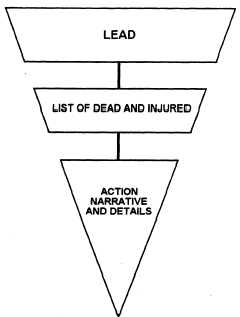The following is an important tenet of Navy public
affairs: Accident news cannot be avoided or withheld,
and it must be released. The amount of information
released varies with security and next of kin
considerations.
Accidents can happen anytime and anywhere.
Because they are unpredictable, unfortunate and
undesirable as a source of news, the JO who covers and
writes accident stories must be especially careful in
handling them.
Accidents involve both life and death. They may
cause human suffering, heartache and anxiety. Also,
because accidents sometimes result from carelessness
or negligence, they may injure reputations or lead to
disciplinary action. A careless word or phrase in an
accident story may cause great damage to the Navy, to
individuals involved and to the careless writer.
Therefore, accuracy is of utmost importance in the
accident story.
Figure 3-6.—Accident/disaster story structure.
In collecting information for a story, the journalist
must be careful to avoid gossip and conjecture. You must
be able to seek out proper authorities and get your
information right the first time. You may not have the
opportunity to verify it later.
You must stick to the concrete facts, resist any
temptation to hide or cover up legitimate news, maintain
high standards of good taste and, above all, be familiar
with security restrictions and other limitations. You must
know what to release and whatnot to release. Never will
your abilities as a JO be put to a more exacting test.
STRUCTURE
In any accident where a number of persons are killed
or injured, the quickest and simplest way of writing the
story is to use the accident/disaster story structure
shown in figure 3-6. This structure is adaptable to all
types of accidents and enables you to get the most
important facts into the beginning of the story.
Lead
Consider this example: “Two San Diego sailors were
The lead of an accident story introduces the reader
to the basic facts in the situation by summarizing the five
Ws and H (who, what, when, where, why and how).
killed and three others seriously injured today when
their automobile blew a tire and smashed into a tree on
Highway 80, five miles east of El Cajon.”
Note that the lead answers all of the five Ws, but
does not elaborate on any of them. The most important
facts in any accident story are the number and identities
of the casualties and the cause of the accident. This lead
immediately satisfies the reader’s initial curiosity about
these facts, but more detailed explanations are saved for
the body of the story.
Since five people are involved in this accident, it
would not be practical to list their names and complete
identities in the lead. Therefore, they are included in the
next segment of the story.
Casualty List
The casualty list contains the names, ranks or
ratings, ages, next of kin, hometown addresses and other
pertinent information available on the dead and injured.
A casualty list for the above lead might be presented in
the proceeding manner (listing should be in alphabetical
order to facilitate readers in scanning the list for known
names):
Dead are:
Seaman Apprentice David K.
Becker, 19, son of Mr. and Mrs. Daniel
M. Becker of 821 Sherman Dr., St.
Louis, Mo.
Seaman Jackson B. Painter, 22, son
of Mr. and Mrs. Carl H. Painter of 680
Deamond St., Elmsdale, R. I., driver of
the car.
3-18



